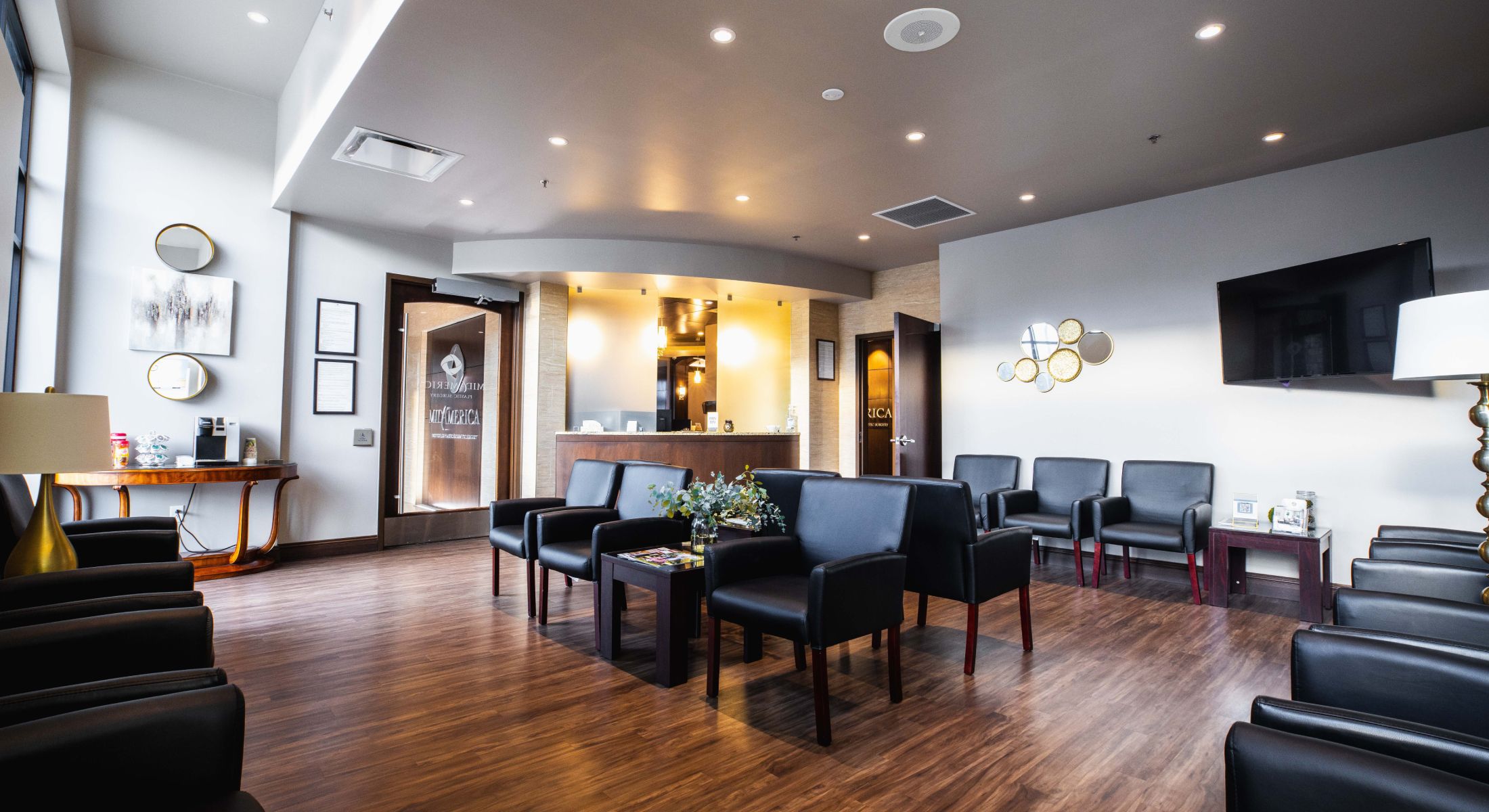All men have a small amount of breast tissue. Breast tissue consists of glandular tissue and fatty tissue. Glandular tissue is responsible for milk production in females but is typically underdeveloped in males. However, even in males, a small amount of glandular tissue is present behind the nipple area. The amount of breast tissue in males is typically minimal and does not cause any visible enlargement or breast-like appearance. It is usually only noticeable in cases of gynecomastia.
Gynecomastia refers to the enlargement of breast tissue in males, resulting in a more feminine chest appearance aka “man boobs”. Men of all ages, from adolescence to adulthood, can be affected by gynecomastia. According to plastic surgery statistics reported by The American Society of Plastic Surgeons, more than 18,000 men underwent gynecomastia surgery in 2020.

Signs & Symptoms of Gynecomastia
It’s important to note that the presence of breast tissue in males is a normal anatomical characteristic and does not necessarily indicate a health problem. The signs and symptoms of gynecomastia can vary depending on the individual and the underlying cause. Some common signs and symptoms associated with gynecomastia:
- Enlarged breast tissue. Gynecomastia is characterized by the enlargement of glandular breast tissue in males. This can affect one or both breasts and may result in a more feminine appearance.
- Breast tenderness or pain. Some individuals with gynecomastia may experience tenderness or discomfort in the breast area. This can range from mild to moderate in severity.
- Swelling and firmness. The breast tissue affected by gynecomastia may feel swollen or firm to the touch. It can be distinguishable from the surrounding fatty tissue in the chest.
- Nipple changes. Gynecomastia can cause changes in the nipples. The nipple may become larger or protrude more than usual. In some cases, the nipple and areola (the darker area surrounding the nipple) may become more sensitive or develop a rubbery or firm texture.
- Psychological impact. Gynecomastia can have psychological and emotional effects on individuals. Some men may experience embarrassment, self-consciousness, or a decrease in self-esteem due to changes in their chest appearance.

Causes of Gynecomastia
It’s important to note that the underlying cause of gynecomastia may vary among individuals, and often it can be a combination of factors. There can be various causes for gynecomastia, including:
- Hormonal imbalances. Hormonal changes, particularly an imbalance between estrogen (female hormone) and testosterone (male hormone), can contribute to gynecomastia. This imbalance can occur during puberty, resulting in temporary breast enlargement, but it usually resolves on its own within a few months to a couple of years. Hormonal imbalances can also be caused by conditions such as hypogonadism (low testosterone levels), hyperthyroidism (overactive thyroid), or certain tumors.
- Medications. Certain medications can induce gynecomastia as a side effect. These may include anti-androgens (used in prostate cancer treatment), anabolic steroids, some anti-anxiety medications (e.g., diazepam), tricyclic antidepressants, antifungal drugs (e.g., ketoconazole), and some medications used for heart conditions.
- Substance abuse. Use of substances like alcohol, marijuana, amphetamines, heroin, or opioids can lead to gynecomastia. These substances can disrupt hormone levels or have a direct effect on breast tissue.
- Health conditions. Some medical conditions can contribute to gynecomastia. These include liver disease (as the liver metabolizes hormones), kidney failure, malnutrition, obesity, genetic disorders (such as Klinefelter syndrome), and tumors of the testes, adrenal glands, or pituitary gland.
- Aging. As men age, their testosterone levels tend to decline, while estrogen levels can remain stable. This hormonal shift can result in an increased risk of developing gynecomastia in older males.
- Herbal products and supplements. Certain herbal products or supplements, such as tea tree oil or lavender oil, contain phytoestrogens, which are plant compounds that mimic estrogen. Prolonged or excessive use of these products may contribute to gynecomastia.
Gynecomastia Frequently Asked Questions
Does gynecomastia have any relation to breast cancer in males?
Breast cancer in males refers to the abnormal growth of malignant (cancerous) cells in the breast tissue. It can present as a lump or thickening in the breast, changes in the nipple or areola, nipple discharge, or other symptoms like those experienced by women with breast cancer. While gynecomastia itself does not increase the risk of breast cancer in males, it is important to understand that breast cancer can occur in men, although it is rare.
Gynecomastia and breast cancer in males are distinct conditions, but they can sometimes coexist or have overlapping symptoms, making it important to evaluate any breast changes in males.
It’s worth noting that gynecomastia is much more common than breast cancer in males. However, if an individual experiences breast changes, such as a new lump or a persistent change in breast tissue, it is crucial to seek medical evaluation. Early detection and diagnosis of breast cancer in males, although uncommon, can lead to better treatment outcomes.
What recommendations are there for recovery tops for men?
After undergoing gynecomastia surgery, it’s important to wear proper compression garments or recovery tops to support the healing process and optimize the results. Here are some recommendations for recovery tops for men after gynecomastia surgery:
- Compression vests. These specially designed vests provide compression and support to the chest area, helping to reduce swelling, promote proper healing, and provide comfort during the recovery period. Compression vests are often recommended by surgeons and are available in many sizes and styles.
- Post-surgical compression shirts. These shirts are specifically designed for post-operative use and offer targeted compression to the chest area. They are often made from soft, breathable materials and have adjustable closures for a customized fit. Some shirts also feature reinforced panels for added support and compression.
- Seamless compression undershirts. Seamless compression undershirts can provide gentle compression while remaining discreet under clothing. Look for seamless designs to minimize irritation and ensure a smooth fit against the skin.
- Zip-up compression tops. Zip-up compression tops can be convenient and easy to put on and take off, especially in the initial stages of recovery when movement and range of motion may be limited. The zip-up design allows for easy adjustment and provides consistent compression.
When selecting a recovery top, choose a size that provides a snug fit without being too tight or restrictive. The fabric should be breathable and comfortable. Also be sure to look for material that is easy to clean. Be sure to follow the care instructions to ensure longevity and proper hygiene.
Can exercise help reduce the appearance of gynecomastia?
Exercise alone may not directly impact the glandular tissue enlargement associated with gynecomastia. Gynecomastia is primarily caused by hormonal imbalances or excess glandular tissue, and exercise cannot target or reduce glandular tissue specifically. However, exercise can play a role in improving the overall appearance of the chest and reducing the prominence of gynecomastia in some cases. Here’s how exercise may help:
- Reducing overall body fat. Engaging in regular exercise and maintaining a healthy weight can help reduce excess body fat, including fat in the chest area. This may help minimize the appearance of gynecomastia if the underlying cause is primarily related to excess fatty tissue (pseudogynecomastia). However, if the enlargement is mainly due to glandular tissue, exercise alone may have a limited impact.
- Building chest muscle. Focusing on chest exercises, such as push-ups, chest presses, and flys, can help build and strengthen the pectoral muscles. By developing the underlying chest muscles, you may achieve a more defined and muscular chest appearance, which can help improve the overall aesthetic of the chest, potentially reducing the prominence of gynecomastia.
It’s important to note that the effectiveness of exercise in improving the appearance of gynecomastia can vary depending on individual factors, such as the underlying cause, the extent of glandular tissue enlargement, and overall body composition. In some cases, surgical intervention may be necessary to achieve a more desired chest contour.
If you feel that you are struggling with gynecomastia, MidAmerica Plastic Surgery is here to offer a solution. Our office is located in Glen Carbon, Illinois, just outside of St. Louis, MO. MidAmerica Plastic Surgery offers personalized consultations with board-certified plastic surgeon, Dr. Ryan Diederich. To learn more about Dr. Diederich, click here. To schedule a consultation, fill out an online form or call our office at 618-288-7855.









